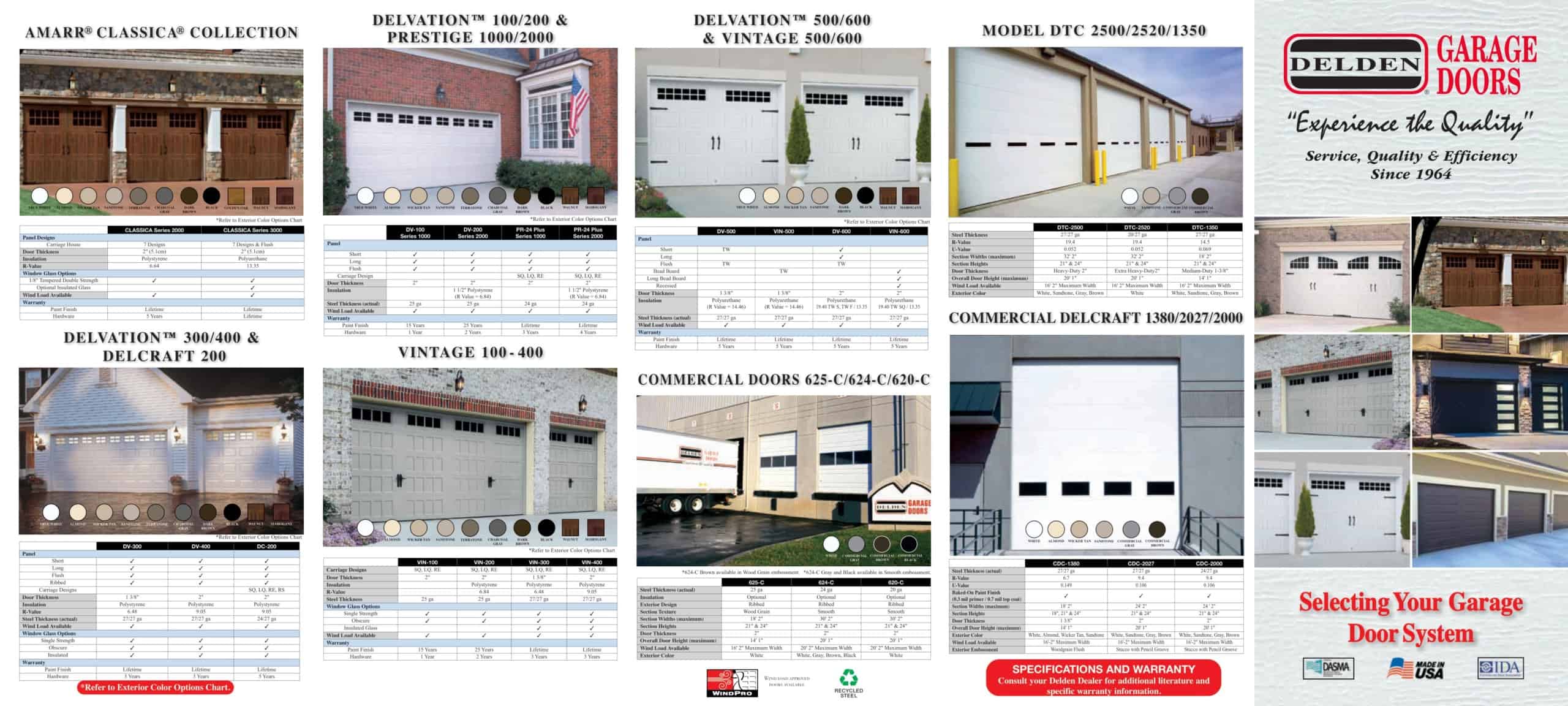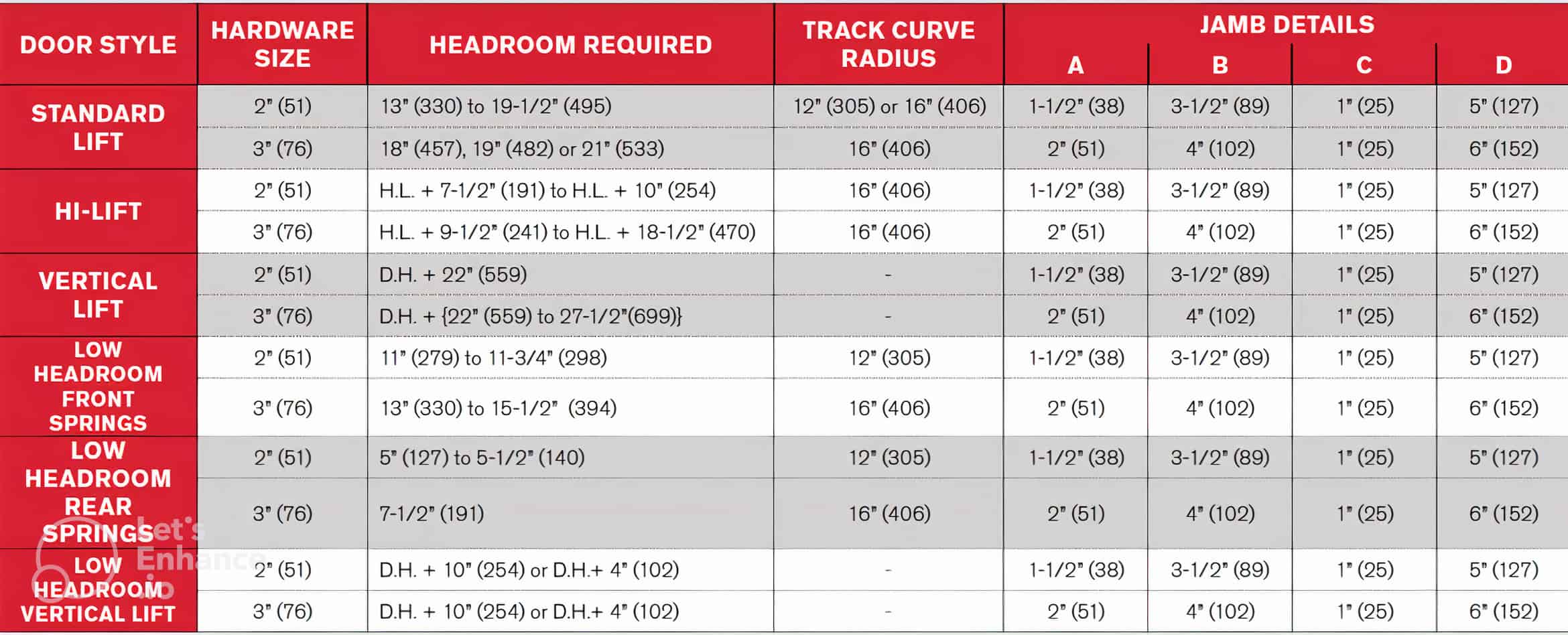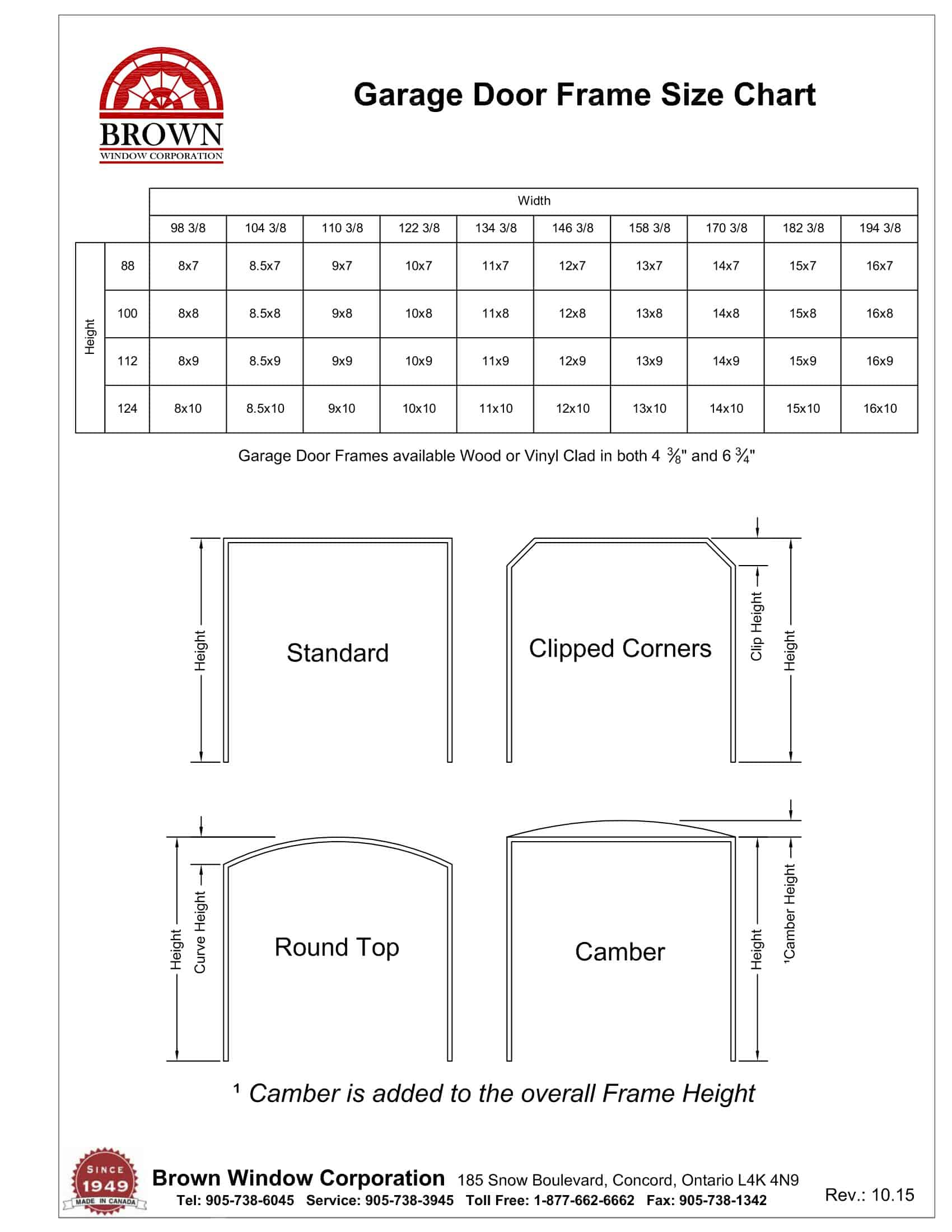If you’re in the process of building or renovating a garage, one important aspect you must consider is the size of the garage door. Choosing the right garage door size is crucial to ensure that your vehicles can easily enter and exit the garage, while also providing sufficient space for storage and other activities. To help you make an informed decision, we have created the ultimate garage door sizes chart, which outlines the different options available for both residential and commercial garages. Whether you own a single vehicle or have multiple cars, this comprehensive guide will provide you with all the information you need to select the perfect garage door size.
Table of Contents
What is a Garage Door Size Chart?

Before we dive into the specifics, let’s take a moment to understand why selecting the correct garage door size is so important. Garage doors not only serve as an entrance and exit point for your vehicles but also contribute to the overall curb appeal of your property. An ill-fitting garage door can not only be an eyesore but also cause a myriad of problems, such as difficulty in maneuvering vehicles in and out of the garage, potential damage to your cars, and limited storage space. Therefore, it is crucial to carefully consider the dimensions of your garage and the vehicles you own to ensure a seamless and functional garage door installation.
Garage Door Sizes Chart Templates
Having the correct garage door size is of utmost importance for various reasons:
- Convenience: A garage door that is too narrow or short can make it challenging to park your vehicle inside the garage comfortably. It can lead to scratches, dings, or even accidents while maneuvering in tight spaces. With a correctly sized garage door, you can enjoy the convenience of effortlessly parking your car.
- Safety: A poorly sized garage door can compromise the safety of your vehicles. If the door is too small, you risk damaging the car when entering or exiting the garage. On the other hand, an oversized door poses a security risk by providing easy access to potential intruders. By selecting the right size, you can ensure the safety of your vehicles and property.
- Storage Space: Your garage can serve as more than just a parking spot. It can be used for storage, a workshop, or other recreational activities. By choosing the correct garage door size, you can maximize the available space and create an organized and functional area for all your needs.
Let’s delve deeper into the importance of convenience when it comes to garage door sizes. Picture this: you’re arriving home after a long day at work, and all you want to do is park your car and relax. However, if your garage door is too narrow, you find yourself struggling to squeeze your vehicle inside. You may end up scratching the sides of your car or even causing dents in the process. Not only is this frustrating, but it can also lead to costly repairs. On the other hand, if your garage door is too short, you may find yourself having to carefully maneuver your car to avoid hitting the top of the door. This can be nerve-wracking and time-consuming, especially when you’re in a hurry.
Now, let’s talk about safety. A poorly sized garage door can pose significant risks to your vehicles. If the door is too small, you may end up damaging your car’s exterior when trying to enter or exit the garage. The last thing you want is to have unsightly scratches or dents on your beloved vehicle. On the flip side, an oversized garage door can be an open invitation for potential intruders. It provides them with easy access to your garage and potentially your home. By selecting the right size, you can ensure the security and protection of your vehicles and property.
Standard Garage Door Sizes
Standard garage door sizes are designed to accommodate most vehicles without any issues. These sizes are widely available and often come with pre-made door options, making them a popular choice for homeowners. The most common standard garage door sizes are:
- Single Garage Door: 8 feet wide by 7 feet tall
- Double Garage Door: 16 feet wide by 7 feet tall
Keep in mind that these dimensions may vary slightly depending on the manufacturer and any additional customization options you choose.
Now that we’ve explored the importance of selecting the correct garage door size and the standard sizes available, you can make an informed decision that suits your needs. Remember, a well-fitted garage door not only enhances the functionality of your garage but also adds to the overall aesthetic appeal of your property.
Garage Door Sizes for Single Vehicles

If you own a single vehicle, such as a compact car or sedan, there are specific garage door sizes that can perfectly accommodate your needs.
When choosing the right garage door size for your vehicle, it’s essential to consider not only the width but also the height of the opening. This ensures that your vehicle can easily maneuver in and out of the garage without any clearance issues.
Compact Cars
Compact cars typically require a slightly smaller garage door compared to larger vehicles. A garage door size of 8 feet wide by 7 feet tall should be sufficient to comfortably park your compact car while allowing enough clearance for smooth entry and exit.
Additionally, if you have a compact car with a roof rack or antenna, you may want to consider a slightly higher garage door to prevent any potential clearance problems.
Sedans
For sedans, which are slightly larger than compact cars, a standard garage door size of 8 feet wide by 7 feet tall is still appropriate. This size ensures that your sedan can easily fit inside the garage without any issues.
It’s worth noting that if your sedan has any modifications that increase its height, such as a lift kit or larger tires, you may need to opt for a taller garage door to accommodate these changes.
SUVs and Trucks
If you own an SUV or a truck, it is important to consider the height and width of your vehicle when selecting a garage door size. SUVs and trucks generally require a larger opening to accommodate their dimensions comfortably. A garage door size of 8 feet wide by 8 feet tall or even 9 feet wide by 7 feet tall would be suitable for most SUVs and trucks.
Keep in mind that some trucks come with roof racks, off-road accessories, or raised suspension, which may necessitate a higher garage door clearance for seamless entry and exit.
Garage Door Sizes for Multiple Vehicles
For households with multiple vehicles, it is essential to choose a garage door size that can accommodate the larger space requirements. Having a garage that can comfortably fit all your vehicles not only provides convenience but also ensures their protection from the elements.
When selecting a garage door size, it’s crucial to consider not only the number of vehicles you own but also their dimensions. Larger vehicles such as trucks or SUVs may require a higher clearance height to fit comfortably inside the garage.
Two-Car Garage Doors
A two-car garage door typically has a width of 16 feet and a height of 7 or 8 feet, depending on the vehicles you own. This size allows you to park two cars side by side comfortably while providing ample space for maneuvering. Additionally, some two-car garage doors come with insulation options to help regulate the temperature inside the garage, which can be beneficial if you use the space for storage or as a workshop.
Three-Car Garage Doors
For households with three vehicles, a three-car garage door is the ideal choice. These garage doors typically have a width of 24 feet and a height of 7 or 8 feet. This size provides enough room for parking three vehicles without feeling cramped. Consider opting for a garage door with windows to allow natural light into the space, creating a more inviting environment and potentially reducing the need for artificial lighting during the day.
Commercial Garage Door Sizes
Commercial garages require larger doors to accommodate various types of vehicles and equipment. Let’s take a look at some common commercial garage door sizes.
When it comes to commercial garage door sizes, one must consider the specific needs of the vehicles and equipment that will be housed within. From RVs to semi-trucks, each type of vehicle requires a different set of dimensions to ensure easy access and functionality within the garage space.
RV Garage Doors
Recreational vehicles (RVs) come in different sizes, ranging from compact campers to large motorhomes. Therefore, it is vital to select a garage door size that can accommodate your specific RV dimensions. Generally, RV garage doors have a minimum height of 14 feet to allow for effective clearance, while the width can vary depending on the size of your RV.
RV owners often opt for garage doors with additional features such as reinforced insulation to protect their vehicles from extreme temperatures and weather conditions. Some garage door manufacturers also offer customization options, allowing RV owners to choose the perfect color and style to complement their vehicle and garage aesthetic.
Semi-Truck Garage Doors
For commercial and industrial garages that need to accommodate semi-trucks, larger garage doors are required. Semi-truck garage doors typically have a width of 18 to 24 feet and a height of 14 to 16 feet, allowing ample space for these large vehicles to enter and exit comfortably.
In addition to size considerations, semi-truck garage doors often feature heavy-duty materials such as steel or aluminum to withstand the weight and size of the vehicles passing through them. Some garage door manufacturers also offer advanced security features for semi-truck garage doors, including remote access control and monitoring systems to ensure the safety and protection of valuable cargo.
Custom Garage Door Sizes
If your garage does not fit into standard size categories or if you have specific preferences, custom garage door sizes offer a solution tailored to your unique requirements.
At Custom Garage Doors Inc., we understand that every garage is different, and that’s why we offer a wide range of custom sizing options. Our team of experts is dedicated to helping you find the perfect fit for your garage, ensuring a seamless and functional garage experience.
Benefits of Custom Sizing
Custom garage door sizes provide several advantages:
- Flexibility: With custom sizing, you have the freedom to design a garage door that perfectly fits your garage’s dimensions and architectural style, creating a cohesive look for your property. Our team will work closely with you to understand your vision and bring it to life.
- Maximized Space: Custom-sized garage doors allow you to take full advantage of the available space, especially if your garage has non-standard dimensions or unique layouts. Whether you have a small garage or a large one, we can customize the size to ensure optimal functionality and aesthetics.
- Increased Property Value: A custom garage door can significantly enhance the curb appeal and overall value of your property, making it an attractive feature for potential buyers in the future. Our high-quality materials and expert craftsmanship ensure a garage door that not only looks great but also stands the test of time.
Process of Custom Sizing
When opting for custom garage door sizes, it is essential to go through a systematic process:
- Consultation: Work with a reputable garage door manufacturer or installer who can guide you through the process. At Custom Garage Doors Inc., our experienced team will assess your garage’s dimensions and discuss your requirements and preferences. We will provide expert advice and recommendations to help you make informed decisions.
- Measurements: Accurate measurements of your garage opening will be taken to ensure a perfect fit. Our team uses advanced measurement techniques to ensure precision and accuracy.
- Design Selection: Choose the style, material, color, and other customization options for your garage door. The manufacturer will provide you with samples and design suggestions to match your vision. From traditional to modern designs, we offer a wide range of options to suit any architectural style.
- Manufacturing and Installation: Once the design and specifications are finalized, your custom-sized garage door will be manufactured and professionally installed by experts. Our team takes pride in delivering superior craftsmanship and attention to detail, ensuring a seamless installation process.
What is clear is that selecting the right garage door size is crucial for a seamless and functional garage experience. By referring to our ultimate garage door sizes chart and considering your specific needs, you can confidently choose the perfect garage door size for your home or commercial space. Remember, a well-sized garage door not only enhances the functionality of your garage but also adds value to your property. So, make an informed decision and enjoy the convenience and comfort of a properly sized garage door.
At Custom Garage Doors Inc., we are committed to providing exceptional customer service and top-quality products. Contact us today to schedule a consultation and start designing your custom-sized garage door.
Garage Door Sizes Chart
| Garage Door Type | Common Sizes (Width x Height) | Material | Insulation | Insulation R-Value | Color Options | Wind Resistance | Windows | Panel Style | Security Features | Automation Compatibility | Price Range | Common Brands |
| Single Door | 8×7, 9×7, 10×7, 8×8, 9×8, 10×8 feet | Steel, Aluminum, Wood, Vinyl, Fiberglass | Yes/No | 6.0-13.0 | White, Almond, Sandstone, Brown, Evergreen | Standard, Hurricane | Yes/No | Raised panel, Flush panel, Carriage House | Manual lock, Auto-lock | Yes/No | $300-$3000 | Clopay, Amarr, Wayne Dalton |
| Double Door | 12×7, 14×7, 16×7, 12×8, 14×8, 16×8 feet | Steel, Aluminum, Wood, Vinyl, Fiberglass | Yes/No | 6.0-13.0 | White, Almond, Sandstone, Brown, Evergreen | Standard, Hurricane | Yes/No | Raised panel, Flush panel, Carriage House | Manual lock, Auto-lock | Yes/No | $600-$5000 | Clopay, Amarr, Wayne Dalton |
| RV Door | 16×8, 16×9, 16×10 feet | Steel, Aluminum, Wood, Vinyl, Fiberglass | Yes/No | 6.0-13.0 | White, Almond, Sandstone, Brown, Evergreen | Standard, Hurricane | Yes/No | Raised panel, Flush panel, Carriage House | Manual lock, Auto-lock | Yes/No | $1000-$10000 | Clopay, Amarr, Wayne Dalton |
| Commercial Door | 24×14, 26×14, 30×14, 24×16, 26×16, 30×16 feet | Steel, Aluminum | Yes/No | 6.0-13.0 | White, Almond, Sandstone, Brown, Evergreen | Standard, Hurricane | Yes/No | Raised panel, Flush panel, Carriage House | Manual lock, Auto-lock | Yes/No | $2000-$20000 | Clopay, Amarr, Wayne Dalton |
| Sectional Door | Variable | Steel, Aluminum, Wood, Vinyl, Fiberglass | Yes/No | Variable | Variable | Standard, Hurricane | Yes/No | Raised panel, Flush panel, Carriage House | Manual lock, Auto-lock | Yes/No | Variable | Variable |
| Roll-up Door | Variable | Steel, Aluminum | No | N/A | Variable | Standard, Hurricane | No | Roll-up design | Manual lock | Yes/No | Variable | Variable |
| Side-hinged Door | Variable | Wood, Steel | No | N/A | Variable | Standard | Yes/No | Variable | Manual lock | No | Variable | Variable |
FAQs
Can I have a custom size for my garage door?
Yes, many manufacturers offer custom garage doors that can be made to fit any size opening. Custom doors can range in width from 8 feet up to 20 feet or more for residential properties, and up to 40 feet or more for commercial properties. The height can also be adjusted based on your specific needs.
Do smaller garage doors require less maintenance?
The size of the garage door does not necessarily dictate the level of maintenance required. All garage doors, regardless of size, should undergo regular inspection and lubrication to ensure they function properly and safely. Issues related to the tracks, springs, and balance of the door should be addressed promptly, regardless of the door’s size.
Can I install a garage door of a different size than the original?
Yes, you can install a different size garage door, but it will often require some construction work to resize the opening, which can add to the cost. It’s also crucial to ensure that the structure can support a larger door, particularly in terms of the side room, headroom, and backroom. Always consult with a professional before deciding to change the size of your garage door.
Is there a standard size for garage door panels?
The size of garage door panels can vary based on the overall door size, but they are often about 21 inches high for a standard 7-foot tall garage door. The width of the panel will match the width of the door.
Are garage door sizes universal?
While there are standard sizes for garage doors, they are not universally applicable to all situations. The ideal garage door size will depend on a variety of factors including the space available, the size of the vehicles you need to accommodate, and personal preference.
What are the typical costs of custom garage doors?
The cost of custom garage doors can vary significantly depending on several factors, including the material, size, design complexity, insulation, and additional features. Here’s a breakdown of the potential costs:
a. Material: Custom garage doors can be made from various materials like wood, steel, aluminum, or fiberglass. Wood doors tend to be more expensive, while steel and aluminum are generally more affordable.
b. Size: Larger custom doors will generally cost more than smaller ones due to the additional materials and manufacturing requirements.
c. Design Complexity: Elaborate designs, custom patterns, and unique features will add to the overall cost.
d. Insulation: Insulated garage doors are more energy-efficient but can be pricier than non-insulated ones.
e. Additional Features: Custom hardware, windows, decorative elements, and smart technology integration can also increase the cost.
As a rough estimate, the cost of a custom garage door can range anywhere from $1,500 to $10,000 or more, depending on the factors mentioned above. It’s recommended to get quotes from multiple garage door manufacturers or suppliers to compare prices and find the best option that fits your budget and preferences.






































![Free Printable Door Hanger Templates [Word, PDF] 1 Door Hanger](https://www.typecalendar.com/wp-content/uploads/2023/05/Door-Hanger-150x150.jpg)
![Free Printable Pie Chart Templates [Excel, PDF, Word] Maker 2 Pie Chart](https://www.typecalendar.com/wp-content/uploads/2023/06/Pie-Chart-150x150.jpg 150w, https://www.typecalendar.com/wp-content/uploads/2023/06/Pie-Chart-1200x1200.jpg 1200w)
![Free Printable Reward Chart Templates [Word, PDF] Teachers 3 Reward Chart](https://www.typecalendar.com/wp-content/uploads/2023/03/Reward-Chart-150x150.jpg 150w, https://www.typecalendar.com/wp-content/uploads/2023/03/Reward-Chart-1200x1200.jpg 1200w)
